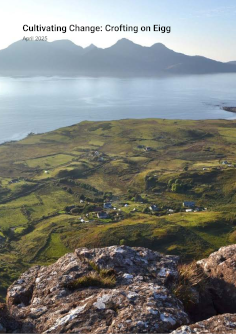A new report has been published, offering an in-depth analysis of the opportunities for the growth and development of crofting on the Isle of Eigg. The report explores how crofting has evolved in recent years, highlights the challenges the island’s crofting community faces, and explores the ways in which community ownership can strengthen and grow crofting.
The report highlights how crofting helps keep Eigg’s cultural traditions alive while also evolving to meet today’s economic and environmental challenges.
It also notes that, without policy changes and investment, we could be sleepwalking into the economic clearance of the crofting areas. It calls for investment in the infrastructure that crofting needs, such as housing, transport and access to markets, as well as reforms to agricultural funding to support small scale producers and horticulture. It highlights the lack of small scale abattoir provision.
The vision for crofting on Eigg articulated in the report is one that shows that crofting is a viable business that attracts young people to stay, return, or move to Eigg. This vision includes a mix of businesses, with sustainable food production at its core. It is a vision where all crofts are being used, where each croft retains its independence, but where there are more opportunities for working in community. And it is one where the whole township manages the land sustainably to ensure it remains both productive and supports biodiversity.
It is hoped that this report will inform policy discussions and inspire further support for small-scale, sustainable land use across the Highlands and Islands.
Report author, Ed Pybus says:
“This project, and report, began when the Isle of Eigg Heritage Trust wanted to look at how best to support crofting on Eigg. From the initial meeting onwards, crofters have led this project. In this report I have tried to distill down six months of conversation, research and observations. Throughout the project, it has become clear that the challenges faced by crofters on Eigg are also seen across crofting communities in Scotland. These challenges are numerous, interconnected, and pose risks to the realisation of the benefits of crofting. At worst, they could lead to the gradual disappearance of crofting.”
Ailsa Raeburn, Chair of the Isle of Eigg Heritage Trust added:
“This report tells an important part of Eigg’s story and highlights the vital role crofting has played in shaping the island’s past, present, and future. It aims to deepen understanding of crofting’s significance and its continued relevance. Rather than being a final word, the report marks a step on the way to growing and strengthening crofting on Eigg.“
Throughout the project several common themes emerged:
Food Production
Crofting has always been primarily about food production. As we look for more sustainable ways to grow food and adapt to the effects of climate change, small-scale local food production will be essential. Crofting is uniquely positioned to play a vital role in this future.
Land Management
Crofters feel a strong responsibility to care for the land. Sustainable land management includes both the sustainable grazing of animals and the planting of trees. The successful development of crofting on Eigg will balance these two priorities to meet the needs of the crofting community as a whole.
Fairer Funding
Without clear, fair funding available, crofting will be unable to continue to deliver the wide range of social, community and environmental benefits it currently provides. Agricultural funding must put the needs of small scale producers at the centre of policy – recognising that small scale producers are the ones who will enable Scotland to be a sustainable, self-sufficient food producing nation, and that crofting provides vital infrastructure that supports rural communities.
Better Infrastructure
Crofting cannot achieve its full potential without the infrastructure needed to support croft-based businesses and communities. Housing, transport and access to markets are all key infrastructure that needs to be in place for crofting to thrive.
Climate change
Climate change presents both risks and opportunities for crofting. As Scotland moves towards a more sustainable food system, crofters will have new opportunities to play a key part in this.
For more information contact
Ed Pybus, Crow Consulting, email: ed@crow.scot, Mob: 07930 536 963
Sue Hollands, Isle of Eigg Heritage Trust, email: ieht.sue@isleofeigg.org
Notes
- The full report is available from isleofeigg.org and crow.scot/eigg
- The Isle of Eigg Heritage Trust: The Isle of Eigg Heritage Trust owns and manages the island on behalf of its residents. The Trust comprises three members: the Isle of Eigg Residents Association, The Highland Council, and the Scottish Wildlife Trust. Representatives from each serve as Directors of the Trust, with Eigg residents forming the majority of the Board. Although The Trust owns the land, much of it is tenanted, including three farms and 22 crofts.
- Crofting: Crofting is a system of landholding, which is unique to Scotland, and is an integral part of life in the Highlands & Islands.
- The project was supported by Highland Council’s Community Regeneration Fund: Community Regeneration Funding (CRF) is an umbrella term used to cover multiple community-led external funding programmes administered by the Highland Council. This includes the Highland Coastal Communities Fund, Place-Based Investment Programme, Community Led Local Development Fund, and UK Shared Prosperity Fund.
